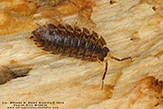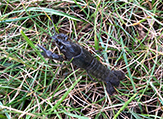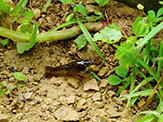Minnesota Crustaceans
Crustacea (crustaceans) is the subphylum of arthropods that is characterized by the following:
- Crustaceans have a hard external skeleton (exoskeleton).
- Most crustaceans are aquatic.
- The head has five appendages: two pairs of antennae, a pair of mandibles (jaws for holding and tearing food), and two pairs of maxillae (for transferring food to the mandibles).
- The head and thorax are fused together (cephalothorax), which is usually covered by a single continuous shield (carapace).
- Early development of most crustaceans includes a stage in which only a few limbs are present (nauplius larval stage). In this stage there is a unique structure with which the larva chews its food (naupliar arthrite), and a single, simple, median eye (naupliar eye).
- Most crustaceans have appendages or limbs on the thorax and abdomen that split into two branches (biramous).
- Crustaceans carry their eggs until they hatch, then release larvae into the water.
The study of crustaceans is called carcinology. There are almost 67,000 to 70,000 crustacean species worldwide. The subphylum consists of mostly free living marine species, but also includes woodlice and sandhoppers, which are terrestrial, fish lice and tongue worms, which are parasites, and barnacles, which are sessile organisms. In North America, about 1,500 freshwater species have been described.
In the United States, 22 crustacean species are protected under the Endangered Species Act. In Minnesota, two are considered invasive.

Recent Additions

Brickwork woodlouse (Porcellio spinicornis) is a large, exotic woodlouse. It is native to Europe, where it is widespread and common. It was introduced into North America, where it now occurs across southern Canada and in the United States from Maine to New Jersey, west to North Dakota and South Dakota. It is not uncommon in Minnesota.
Brickwork woodlouse favors dry areas with limey (calcareous) surfaces. It is found in limestone quarries, on limestone pavement, in loosely mortared walls, and often in human houses. It is active at night, when it can be found on the surface. During the day it remains concealed, often under a rock or log.
Brickwork woodlouse is yellowish with dark brown to almost black mottling, and a dark brown to almost black stripe in the middle bordered on each side by bright yellow markings. One imaginative describer likened the pattern to brickwork, and this is the source of this species’ common name.

Rathke’s woodlouse is a non-native isopod. It is native to central Europe, was introduced into North America, and now occurs from Newfoundland south to Tennessee and west to South Dakota. It is not uncommon in Minnesota. It is found in places with at least some dampness, including on rotting logs; under logs, stones, and boards; and in woodsheds and greenhouses. It is mostly a scavenger, eating plant and animal organic matter, but sometimes also feeds on living plants.
Unlike pill woodlice (Family Armadillidae), Rathke’s woodlouse cannot roll into a ball.

Rusty crayfish (Orconectes rusticus) is a medium- to large-sized freshwater crustacean. It is native to Michigan, Ohio, and Kentucky. It is used extensively by fishermen as bait, and is sold as an aquarium pet. Unused bait and release of aquarium pets have resulted in the introduction of this species across the United States. It is considered invasive outside of its native range.
Rusty crayfish are extremely aggressive. They out-compete and eventually eliminating native crayfish species when introduced into a new site. Juveniles have a higher metabolic rate, eat twice as much, and develop much faster than native crayfish species of similar size.
Rusty crayfish is identified by a rust-colored spot on each side of its upper shell; a rust-colored stripe on the uppers side of its abdomen; and very large claws with an S-shaped movable finger.

Virile crayfish (Orconectes virilis) is a medium- to large-sized freshwater crustacean. It is widespread and abundant across North America. It is native to central United States and Canada, from Quebec to Tennessee in the east, to Alberta and Colorado in the west. It is introduced and considered invasive outside of its native range from coast to coast.
Virile crayfish prefer streams with rocky bottoms, moderate flow and turbidity, abundant cover, and stable water levels. They often use rocks, logs, or other organic debris as cover. They occasionally dig burrows into muddy banks, especially when water levels are low. To survive the winter, they migrate to deeper water that does not completely freeze and they become inactive.
Virile crayfish are identified by the dappled, olive-brown body with pairs of dark brown splotches on the abdomen; the shape of the shield (carapace) covering the front part of the body; and the broadly flattened, usually bluish claws.
Other Recent Additions
This list includes only crustaceans that have been recorded in Minnesota, but not all of the crustaceans found in Minnesota.
| Profile | Photo | Video | |||
|---|---|---|---|---|---|
|
|
|||||
burrowing amphipods (Diporeia spp.) |
|||||
calico crayfish (Faxonius immunis) |
|||||
common pill bug (Armadillidium vulgare) |
|||||
Couse tadpole shrimp (Lepidurus couesii) |
|||||
curly woodlouse (Cylisticus convexus) |
|||||
devil crayfish (Cambarus diogenes) |
|||||
eastern alkali fairy shrimp (Branchinecta readingi) |
|||||
eastern fairy shrimp (Eubranchipus holmanii) |
|||||
Ellis Bog crangonyctid (Crangonyx richmondensis) |
|||||
freshwater shrimp (Gammarus fasciatus) |
|||||
golden crayfish (Faxonius luteus) |
|||||
holarctic clam shrimp (Lynceus brachyurus) |
|||||
knobbedlip fairy shrimp (Eubranchipus bundyi) |
|||||
northern clearwater crayfish (Faxonius propinquus) |
|||||
northern river crangonyctid (Crangonyx pseudogracilis) |
|||||
northern spring amphipod (Gammarus pseudolimnaeus) |
|||||
ornate fairy shrimp (Eubranchipus ornatus) |
|||||
powder blue isopod (Porcellionides pruinosus) |
|||||
red swamp crayfish (Procambarus clarkii) |
|||||
scud (Hyalella azteca) |
|||||
smoothlip fairy shrimp (Eubranchipus intricatus) |
|||||
spinytail fairy shrimp (Streptocephalus sealii) |
|||||
White River crawfish (Procambarus acutus) |
Armadillidium vulgare (common pill bug)
Armadillidium nasatum (nosy pill woodlouse)
Branchinecta readingi (eastern alkali fairy shrimp)
Cambarus diogenes (devil crayfish)
Crangonyx pseudogracilis (northern river crangonyctid)
Crangonyx richmondensis (Ellis Bog crangonyctid)
Cylisticus convexus (curly woodlouse)
Diporeia spp. (burrowing amphipods)
Eubranchipus bundyi (knobbedlip fairy shrimp)
Eubranchipus holmanii (eastern fairy shrimp)
Eubranchipus intricatus (smoothlip fairy shrimp)
Eubranchipus ornatus (ornate fairy shrimp)
Faxonius immunis (calico crayfish)
Faxonius luteus (golden crayfish)
Faxonius propinquus (northern clearwater crayfish)
Faxonius rusticus (rusty crayfish)
Faxonius virilis (virile crayfish)
Gammarus fasciatus (freshwater shrimp)
Gammarus pseudolimnaeus (northern spring amphipod)
Hyalella azteca (scud)
Lepidurus couesii (Couse tadpole shrimp)
Lynceus brachyurus (holarctic clam shrimp)
Porcellio spinicornis (brickwork woodlouse)
Porcellionides pruinosus (powder blue isopod)
Procambarus acutus (White River crawfish)
Procambarus clarkii (red swamp crayfish)
Streptocephalus sealii (spinytail fairy shrimp)
No Species Page Yet?
If you do not see a linked page for a species in the list at left you can still upload a photo or video or report a sighting for that species. Click on one of the buttons below and type in the common name and/or scientific name of the species in your photo, video, or sighting. A new page will be created for that species featuring your contribution.
These buttons not working for you?
Simply email us at info@MinnesotaSeasons.com.





